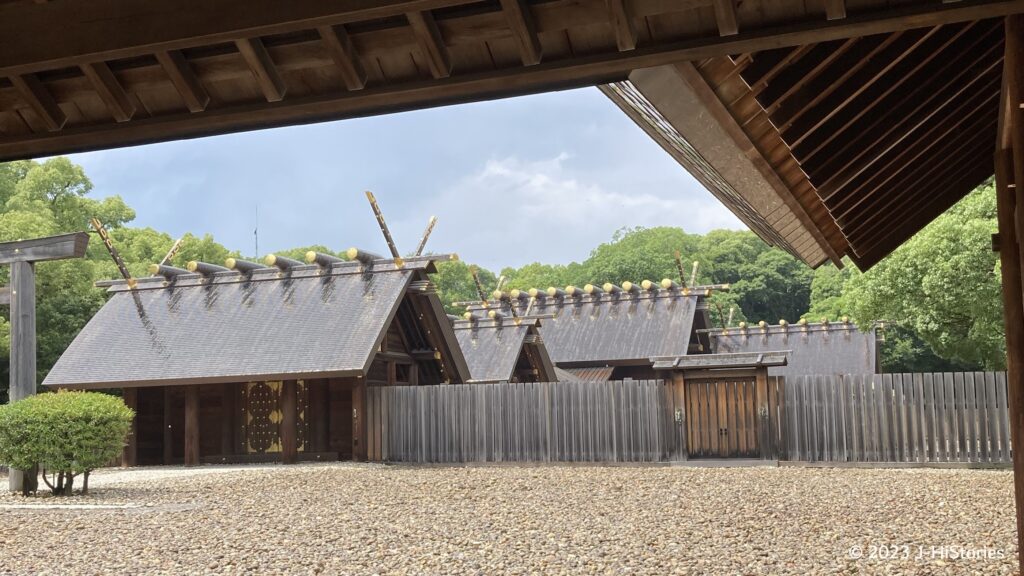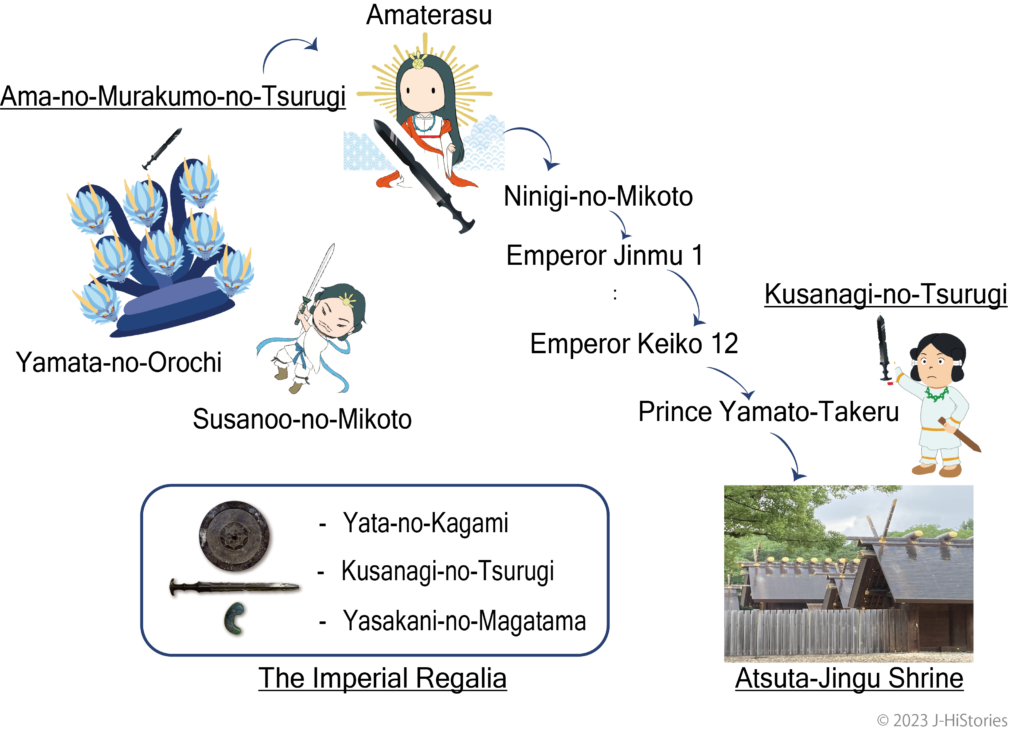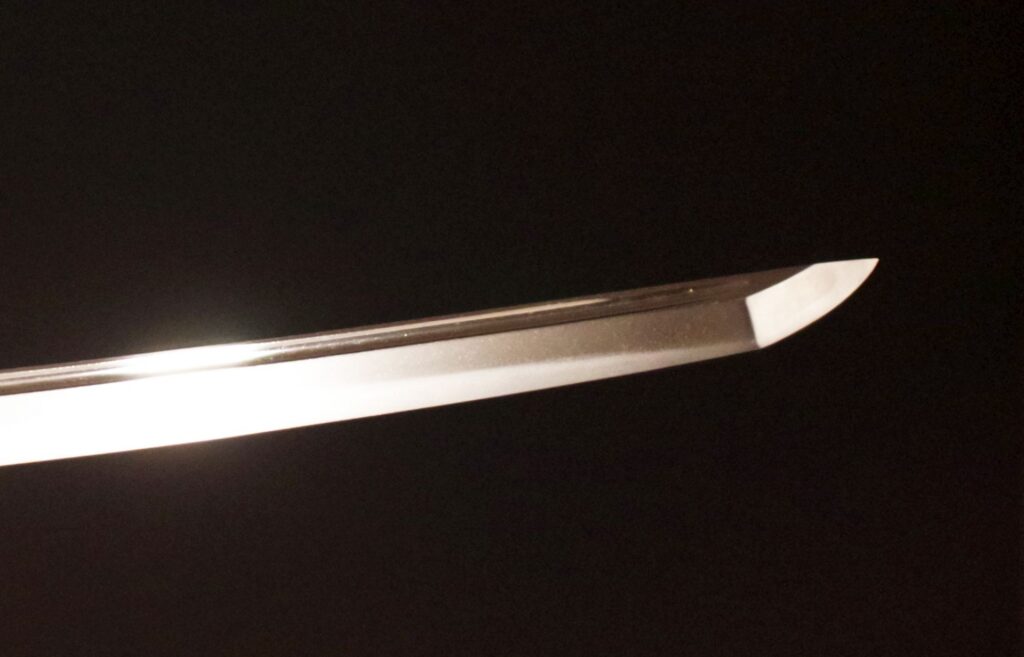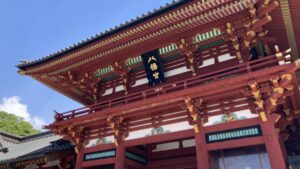Atsuta Jingu Shrine, Enshrines a Sacred Sword, "Kusanagi-no-Tsurugi"
Atsuta Jingu Shrine has a long history being established in 113. It is a significant shrine enshrining a sacred sword, the Ama-no-Murakumo-no-Tsurugi, later known as Kusanagi-no-Tsurugi, as one of three types of ritual vessels that have been handed down in the Japanese imperial family since ancient times. As a shrine associated with the Imperial Family, it houses approximately 6,000 treasures donated by the Imperial Family and many samurai. The museum exhibits 20 swords designated as national treasures, important cultural properties, and other valuable swords, paintings, and other materials related to swords. The swords have spirituality and vitality as votive offerings to the deities; the light emitted by the swords themselves cannot be expressed in words.

The Kusanagi Sword in Mythology Became the Imperial Treasure
The origin of the Kusanagi Sword is introduced in Kojiki (Records of Ancient Matters as the oldest book in existence). The sword emerged from the tale of a monstrous snake, Yamata-no-Orochi when a deity Susanoo-no-Mikoto slew it just before it ate Kushinada-Hime (a lady in Izumo province). The name of the Ama-no-Murakumo Sword (sword of the heavenly gathering clouds) comes from the legend that clouds always hang over Yamata-no-Orochi. This myth seems to link to the fact that Susanoo or a powerful man like Susanoo cultivated new rice fields by irrigating the frequently flooded Hii-river with several advanced technologies. This is backed up by another myth that Kusjinada-Hime married Susanoo is regarded as the deity of rice fields. After the victory, Susanoo presented its sword to his sister, Amaterasu (A deity of the Sun and its direct descendants are Japanese Emperors). Amaterasu granted the three sacred treasures, one of which was the sword, to her grandson, Ninigi-no-Mikoto, and ordered him to rule over the Mizuho-no-Kuni (a eulogistic name of Japan blessed with rice). The 1st Emperor Jinmu (神武天皇), the grandson of Ninigi-no-Mikoto, is said to have built the Yamato government (Japan) in Nara. After that, the sword and the mirror were moved to the Ise Jingu shrine (伊勢神宮), and their Katashiro (replicas) were made and kept in the palace. The Imperial Regalia consists of the mirror (Yata-no-Kagami), the sword (Kusanagi-no-Tsurugi), and the jewel (Yasakani-no-Magatama). These three treasures symbolize the emperor’s authority and are mandatory items for the emperor to succeed on the Imperial Throne.


Swords Acquired Spiritual Power
In the reign of the 12th Emperor Keiko (景行天皇), the prince Yamato Takeru marched into Sagami Province to pacify the eastern provinces with the sacred Ama-no-Murakumo-no-Tsurugi sword, which he received from the Ise Jingu Shrine. He was on the verge of burning death from a fire set by his enemies in the midst of thick grass. He desperately cut off the grass, could control the wind-fanned fire direction to his enemies thanks to the sacred sword’s power, and escaped the disaster. Thus, it earned the name Kusanagi-no-Tsurugi (Grass-Cutting Sward). However, leaving the sword in his wife’s care, he died on the next expedition. Later, his wife enshrined the sword at the newly built Atsuta-Jingu Shrine. This story expresses the spiritual power that dwells in the sword. From ancient days, a sword has long been acknowledged as something sacred by Japanese people.
Kusanagi Sword Sank Into the Sea

In the late Heian period (794-1185), during the Battle of Dannoura between two major Samurai; Minamoto Yoritomo & Yoshitsune and Taira Kiyuomori's family in 1185, losing the momentum, the Taira family and the 81st Emperor Antoku (1178-1185, 安徳天皇), who was of Taira blood, threw themselves into the sea one by after with the three sacred treasures. The mirror and the jewel were found and pulled out of the sea, but the Kusanagi Sword sank deep under the sea. The 82nd Emperor Go-Toba (1180-1239,後鳥羽天皇) then ascended to the throne without the complete set of the three sacred treasures. It is unclear whether it was due to the lack of swords or not, but later, Emperor Go-Toba was exiled from Kyoto to the isolated island of Oki after losing a battle against the Kamakura Shogunate.
Sward is Samurai’s Soul
During the Samurai period from the 12th century to the end of the Edo period (1603-1868), the sword was the Samurai’s soul representing the spirits of loyalty, simplicity, courtesy, integrity, and perseverance, though it was also a powerful weapon in battle. Samurai, who faced the risk of death every day and serious competition where a loss could end the entire family, received the power of zest for life from the sword through its beauty, shape, Hamon (blade crest), sharpness, and dignity. The Japanese sword’s uniqueness is “do not break, do not bend” and was manufactured by several craftsmen who were highly skilled with advanced techniques.
Sword in which a Deity Resides

When a sword craftsman makes a sword, he prays for the swordsmith deity wearing a white cloth, which denotes holiness and purity. Thus, the sword is believed to have a deity inside. Even now, it’s believed that the sword has spiritual power. The Imperial family presents one sword to a newborn baby to protect it. Please enjoy the Atsuta Jingu Shrine and its Kusanagi-kan Museum where you can feel the spirituality and vitality of swords while thinking about the story of the Kusanagi-no-Tsurugi sword. The light emitted by the swords themselves cannot be expressed in words.
Recommendations to visit
- Access: 10 min from Nagoya Station to Jingu-mae Station by Meitetsu Line. Then a 5-minute walk.


